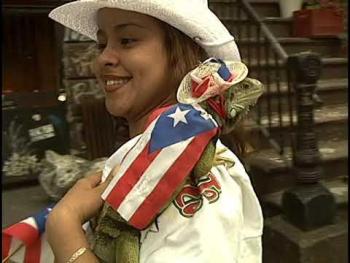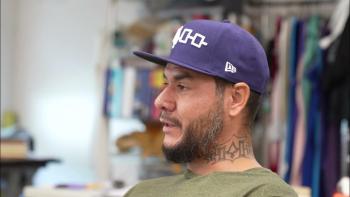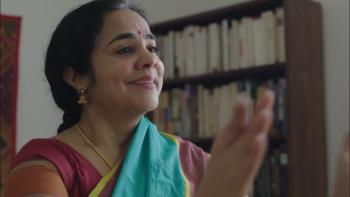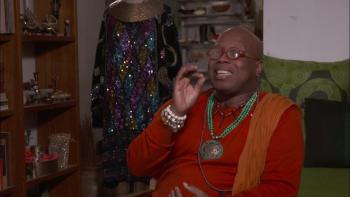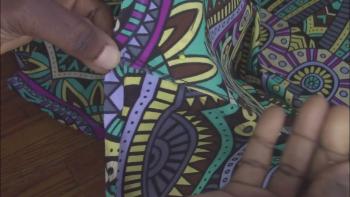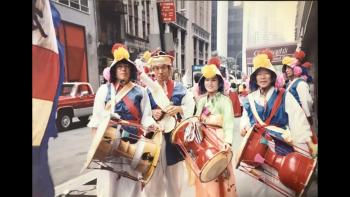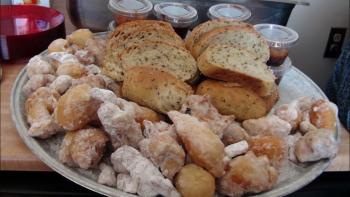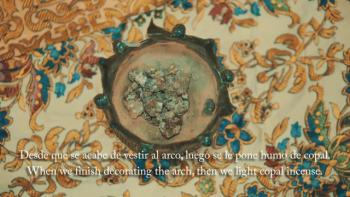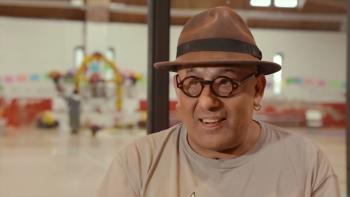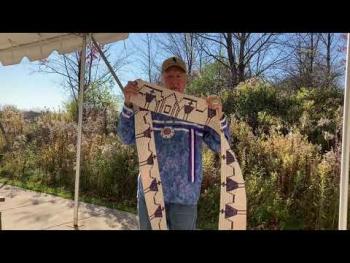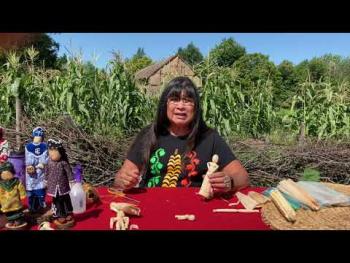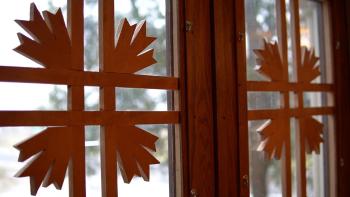Browse Digital Heritage
The display of la bandera puertorriqueña was pretty common all year long throughout the five boroughs of New York City, waving from car antennas, painted on wall murals, or draped from windows, fire escapes and card hoods; but from the end of May until the middle of June,prior to and during the National Puerto Rican Day Parade in Manhattan (always the second Sunday in June), it reaches its peak. It is hard to walk anywhere in the City without seeing the image proudly displayed or worn. Any item or apparel imaginable is adorned or decorated with the image: umbrellas, shorts, ties, fingernails, hats, jewelry, sunglasses. This was especially true from the late 1990s through the early 2000s. It appears as if this custom may have peaked a few years ago, and during the last few years the flag seems to be less visible in the time period leading up to the parade. This latest trend may have arisen due to do with grassroots and official campaigns intended to make sure the flag is used only in a respectful manner, a decline in the flag fever pitch of those years and recent economic and environmental crises on the island leading many to use a black and white monoestrellada to represent the dual ideas of mourning and resistance.
Place
Material Culture
Onöndowa’ga:’ (Seneca) bone and antler carver, Hayden Haynes (Deer Clan), shares his inspirations, creative process, and the multifaceted approach he employs to hone his skills and revitalize the ancestral craft within his community.
Material Culture
All of us as have two experiences in common — birth and death. One is greeted with joy and celebration; the other is often accompanied by a wide range of emotions such as fear, relief, sorrow, joy, grief, and loss. In the process of dying, and in death itself, cultural practices and rituals play a key role in the individual’s and family’s experience of end-of-life. Understanding how death and dying have come to be expressed in culturally-specific traditions and diverse art forms offers remarkable insight into end-of-life situations, allowing healthcare professionals to develop essential cultural competencies and increased empathy.
The End-of-Life Toolkit is a set of resources that accompanies an eLearning course entitled “Heritage to Health: Harnessing the Power of the Arts for End-of-Life Care”. The Toolkit provides resources on death and dying, geared to both health professionals and the public. It contains links to textbooks, stories, poems, cultural perspectives on death and dying, as well as compelling video clips, examples of various art forms, and “how to” information for creating various types of memorials when an individual passes away. The Toolkit expands the opportunities for healthcare providers to enhance their skills in end-of-life care through the use of the Arts. It focuses on ways to create a culturally sensitive yet individualized environment for those at the end-of-life, using the Arts as a clinical tool for supporting patients’ beliefs, traditions, and customs in a meaningful way.
Developed by City Lore and the Nurse Practitioner Healthcare Foundation. Funded by the Robert Wood Johnson Foundation and the National Endowment for the Arts.
Dance
Belief
All of us as have two experiences in common — birth and death. One is greeted with joy and celebration; the other is often accompanied by a wide range of emotions such as fear, relief, sorrow, joy, grief, and loss. In the process of dying, and in death itself, cultural practices and rituals play a key role in the individual’s and family’s experience of end-of-life. Understanding how death and dying have come to be expressed in culturally-specific traditions and diverse art forms offers remarkable insight into end-of-life situations, allowing healthcare professionals to develop essential cultural competencies and increased empathy.
The End-of-Life Toolkit is a set of resources that accompanies an eLearning course entitled “Heritage to Health: Harnessing the Power of the Arts for End-of-Life Care”. The Toolkit provides resources on death and dying, geared to both health professionals and the public. It contains links to textbooks, stories, poems, cultural perspectives on death and dying, as well as compelling video clips, examples of various art forms, and “how to” information for creating various types of memorials when an individual passes away. The Toolkit expands the opportunities for healthcare providers to enhance their skills in end-of-life care through the use of the Arts. It focuses on ways to create a culturally sensitive yet individualized environment for those at the end-of-life, using the Arts as a clinical tool for supporting patients’ beliefs, traditions, and customs in a meaningful way.
Developed by City Lore and the Nurse Practitioner Healthcare Foundation. Funded by the Robert Wood Johnson Foundation and the National Endowment for the Arts.
Ritual
Belief
BPL Ambassador, Saratu Mshelia’s tutorial is to teach how to hand sew a Buba Blouse, a traditional Yoruba blouse of Southwestern Nigeria, as she tells us about her journey starting a fashion business based on Nigerian textiles.
Material Culture
Documentary interview with Chi-Chung Kim, a folklorist who specializes in Korean percussive music, by Vong Pak at Mr. Kim's home in Queens. Chi-Chung Kim speaks about his 70 years playing Korean traditional pungmul percussive music and what Korean music means to him."
Music
The St. Joseph's Day Table is a primarily Italian American tradition that honors the saint on his feast day, March 19. It recalls the answer to prayers for rain from drought-stricken faithful in Sicily in the Middle Ages, and their subsequent offering of a meal for travelers, strangers, the poor and the entire community in thanksgiving. This video takes you to a Table hosted by Bernice Hotchkiss in 2019, where she describes the foods and recalls how she began learning the recipes from older women in her community. The accompanying notes give more details on the traditional foods, their symbolism and current practice in western New York.
Ritual
Foodways
Belief
Porfiria Mijangos explains the elements of a traditional ofrenda for Day of the Dead in her region of Oaxaca, Mexico. Interview and footage are from the Day of the Dead celebration at Orleans YMCA, Medina, New York, November 1 2019. Members of her extended family built the large ofrenda seen here for the annual community-wide event.
Ritual
Foodways
Material Culture
Belief
The video documents the creation of a Oaxacan sand painting by Antonio Cruz Zavaleta, for Dia de los Muertos/Day of the Dead celebration on November 1, 2019, held at the Orleans County YMCA, Medina NY.
Ritual
Material Culture
Belief
Otgoä (wampum) is a vital part of Haudenosaunee culture. Wampum are shell beads that are created from whelk and quahog clam shells. The brittle pieces are rounded, sanded, and drilled to make a bead. Because of the effort that is needed to make a bead, wampum is highly valued.
Material Culture
Haudenosaunee storytelling is not meant to just entertain but to also teach. Stories are used to warn against dangerous and bad behavior, uphold valued qualities, and teach good decision making. If you travel to different Haudenosaunee communities, you will discover that each community may have their own version of a story. There is no one version that is upheld over the others, but if you listen you will discover that although the details may be slightly different, the lessons taught remain the same.
Material Culture
Learn from longtime carpenter Arthur Garabedian about growing up in the Armenian community in Niagara Falls, teaching carpentry at the renowned Trott Vocational School in Niagara Falls (NY), and his work on local community projects, including the front doors of St. Sarkis Armenian Church, which brightly feature his design of the Armenian cross.
Material Culture
Occupation
Search
Tradition
- Music (49) Apply Music filter
- Material Culture (29) Apply Material Culture filter
- Ritual (20) Apply Ritual filter
- Place (15) Apply Place filter
- Foodways (14) Apply Foodways filter
- Verbal Arts (14) Apply Verbal Arts filter
- Belief (13) Apply Belief filter
- Dance (11) Apply Dance filter
- Occupation (10) Apply Occupation filter
- Migration (6) Apply Migration filter
- Health (4) Apply Health filter
- Games (1) Apply Games filter
Collection
- Survive, Remember, Thrive: Armenian Traditions in Western New York (9) Apply Survive, Remember, Thrive: Armenian Traditions in Western New York filter
- Brooklyn Folk & Folk Artists Series (7) Apply Brooklyn Folk & Folk Artists Series filter
- The Non-Gujarati Jains (5) Apply The Non-Gujarati Jains filter
- Freeport Waters (4) Apply Freeport Waters filter
- Lullabies of New York (4) Apply Lullabies of New York filter
- Superstorm Sandy (4) Apply Superstorm Sandy filter
- NYSCA-New York Folklore Upstate Regional Initiative (3) Apply NYSCA-New York Folklore Upstate Regional Initiative filter
- Heritage Ambassadors (2) Apply Heritage Ambassadors filter
- Made of Thunder, Made of Glass II (2) Apply Made of Thunder, Made of Glass II filter
- New York City Beatz Coronavirus (2) Apply New York City Beatz Coronavirus filter
- Instructional Materials (1) Apply Instructional Materials filter
- North Country Heritage Awards (1) Apply North Country Heritage Awards filter
Community
- Brooklyn Arts Council (28) Apply Brooklyn Arts Council filter
- Castellani Art Museum of Niagara University (16) Apply Castellani Art Museum of Niagara University filter
- City Lore (10) Apply City Lore filter
- Long Island Traditions (9) Apply Long Island Traditions filter
- Arts Westchester (7) Apply Arts Westchester filter
- Endangered Language Alliance (6) Apply Endangered Language Alliance filter
- The Arts Council of the Southern Finger Lakes (6) Apply The Arts Council of the Southern Finger Lakes filter
- New York Folklore (5) Apply New York Folklore filter
- Staten Island Arts (4) Apply Staten Island Arts filter
- Traditional Arts Upstate New York (4) Apply Traditional Arts Upstate New York filter
- Esraa Warda (3) Apply Esraa Warda filter
- GO Art (3) Apply GO Art filter
- Brooklyn Public Library (2) Apply Brooklyn Public Library filter
- Center for Traditional Music and Dance (2) Apply Center for Traditional Music and Dance filter
- New York State Old Tyme Fiddlers' Association (2) Apply New York State Old Tyme Fiddlers' Association filter
- The Folklife Center at Crandall Public Library (2) Apply The Folklife Center at Crandall Public Library filter
- Mind-Builders Creative Arts Center (1) Apply Mind-Builders Creative Arts Center filter
Culture
- United States (11) Apply United States filter
- Armenia (9) Apply Armenia filter
- India (8) Apply India filter
- African-American (4) Apply African-American filter
- China (4) Apply China filter
- Finland (4) Apply Finland filter
- Pakistan (4) Apply Pakistan filter
- Tajikistan (4) Apply Tajikistan filter
- American (3) Apply American filter
- Haudenosaunee (3) Apply Haudenosaunee filter
- Mexico (3) Apply Mexico filter
- Paraguay (3) Apply Paraguay filter
- Puerto Rico (3) Apply Puerto Rico filter
- Trinidad and Tobago (3) Apply Trinidad and Tobago filter
- Dominican Republic (2) Apply Dominican Republic filter
- Morocco (2) Apply Morocco filter
- Russia (2) Apply Russia filter
- Ukraine (2) Apply Ukraine filter
- Uzbekistan (2) Apply Uzbekistan filter
- Algeria (1) Apply Algeria filter
- Arab (1) Apply Arab filter
- Bhutan (1) Apply Bhutan filter
- Canada (1) Apply Canada filter
- Gambia (1) Apply Gambia filter
- Ghana (1) Apply Ghana filter
- Guinea (1) Apply Guinea filter
- Guinea-Bissau (1) Apply Guinea-Bissau filter
- Guyana (1) Apply Guyana filter
- Ireland (1) Apply Ireland filter
- Israel (1) Apply Israel filter
- Italy (1) Apply Italy filter
- Japan (1) Apply Japan filter
- Korea, South (1) Apply Korea, South filter
- Lebanon (1) Apply Lebanon filter
- Mohawk Nation at Akewesasne (1) Apply Mohawk Nation at Akewesasne filter
- Mongolia (1) Apply Mongolia filter
- Nigeria (1) Apply Nigeria filter
- Onöndowa’ga:’ (Seneca) (1) Apply Onöndowa’ga:’ (Seneca) filter
- Peru (1) Apply Peru filter
- Sri Lanka (1) Apply Sri Lanka filter
- Turkey (1) Apply Turkey filter

